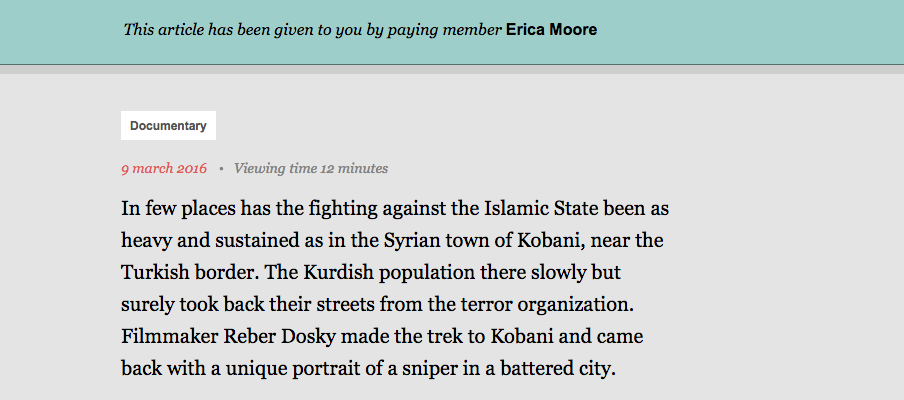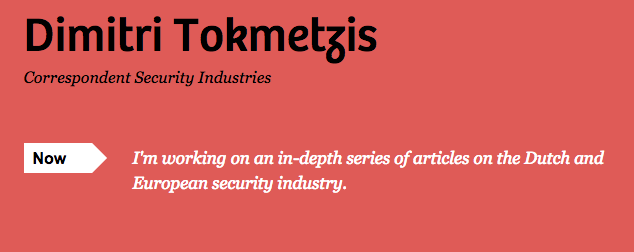Dutch publisher The Correspondent has grown to 47,000 paying subscribers

Dutch publisher The Correspondent is adding around a thousand new members each month. With this growth, it’s on track to reach the 50,000 subscriber milestone by the year’s end.
Rather than follow the hype cycle of daily news, it covers topics that have an ongoing daily impact on readers. “Instead of the weather, we cover climate change,” explained Ernst-Jan Pfauth, publisher and co-founder of The Correspondent.
It publishes roughly five articles a day, of around 2000 words, from its 20 full-time writers and freelance network. At launch in September 2013, it had eight journalists. In the last year, it has doubled overall staff count to 31. For the last few months, it has been publishing one article a week in English, like “A day in the life of a sniper fighting ISIS,” and “What we give away when we log on to a public Wi-Fi network,” to test the appetite for international expansion.
Coming from a print background, Pfauth saw how ads corrupted content: New travel or career sections sprung up because they were easy to sell against, rather than to serve any reader need. With no ads, the Correspondent makes 90 percent of its revenue from its 47,000 subscribers, who pay roughly €60 ($67) a year, or €6 ($6.70) a month, (10 percent is from book sales with profits invested back into the company). Annual retention rate is high at 83 percent. Here’s how The Correspondent is attracting readers and keeping them:
A flexible paywall
Any paying member can share any article freely. Pfauth explained it’s a member’s right as they pay for the service, but also, perhaps more realistically, trying to quash people sharing articles is futile.
Readers who click the link get access to read just that article. They are also told which paying member of The Correspondent has shared it and are then asked whether they want to subscribe. It’s the publisher’s most successful source of new membership. Each week, members hit the share button on The Correspondent’s site roughly 10,000 times (mostly to Facebook); 300 of these turn into paying subscribers.
This success, Pfauth believes, is down to the feeling of community between journalists and readers. “We present the journalism as a service and make it clear that we can’t exist without their support.”
“We explain from the first moment what we are trying to do, and that is to create better journalism with the help of our readers,” he added. “Our journalists are the conversation leaders; our readers are the contributing experts.”

Interactive journalism
Each journalist states what they are working on for the next month or so on their profile page. This could be the Dutch and European security industry, the amount of bureaucracy within the healthcare system or the unknown power players in the music industry. A call for sources and ideas goes out in the weekly newsletter (the publisher has 49 newsletters in total). In the case of the music industry piece, the journalist received hundreds of responses. For bureaucracy in healthcare, doctors got in touch complaining they spent a day every week filling out paperwork for insurance companies.
Journalists keep readers up to date with their progress through weekly emails, almost like status reports on their progress; there’s no format for this: Some share interview transcripts, the most interesting quotes so far, or any relevant images, even jokes.
It’s a novel approach, and not one for all journalists, but it seems to be working. Most of correspondents have around 6,000 subscribers to their own personal email newsletter. The newsletter from the climate correspondent has an open rate of 58.6 percent and a click-through rate of 14.8 percent, which is typical of other newsletters from the publisher. Mailchimp’s industry benchmarks are much lower, ranging between 17 and 27 percent, with open rates in the low single figures.

A platform for experts
Most of the published articles end with a question to start the ball rolling in the comment section. Members have to contribute under their real name and are often asked to write guest articles for the site. “The main goal get people to share knowledge in a world where comments are a space for conspiracy thinkers,” explained Pfauth.
There are three types of contributions The Correspondent welcomes: when a reader shares their experience, asks a question or shares a link to another resource. Just expressing an opinion isn’t encouraged. It doesn’t go for quantity, though the number of contributions on articles can range from 10 to 500. Of course, there are a few trolls, but after three years and 80,000 contributions, The Correspondent has only banned around 10 people, usually for profanities.
The next step is building out the right technology to help the publisher discover more experts on the platform, like a scorecard for when readers contribute information that’s useful to the research process, and add to their profile as experts.
It’s a win-win situation, according to Pfauth: “On the business side, it means we have more loyal readers, and on the journalism side, it means more sources and shared knowledge.”
Image courtesy of The Correspondent via Facebook, photo credit Lisa Klaverstijn.
More in Media

Here are the biggest moments in AI for publishers in 2025
Here are some of the moments that defined how publishers adapted to the AI era this year.

Digiday+ Research roundup: Gen Z news consumption and diversification in the DSP space were 2025’s top trends
As 2025 winds down, we rounded up the biggest trends of the year, based on the data that resonated the most with Digiday’s readers.

What publishers are wishing for this holiday season: End AI scraping and determine AI-powered audience value
Publishers want a fair, structured, regulated AI environment and they also want to define what the next decade of audience metrics looks like.





